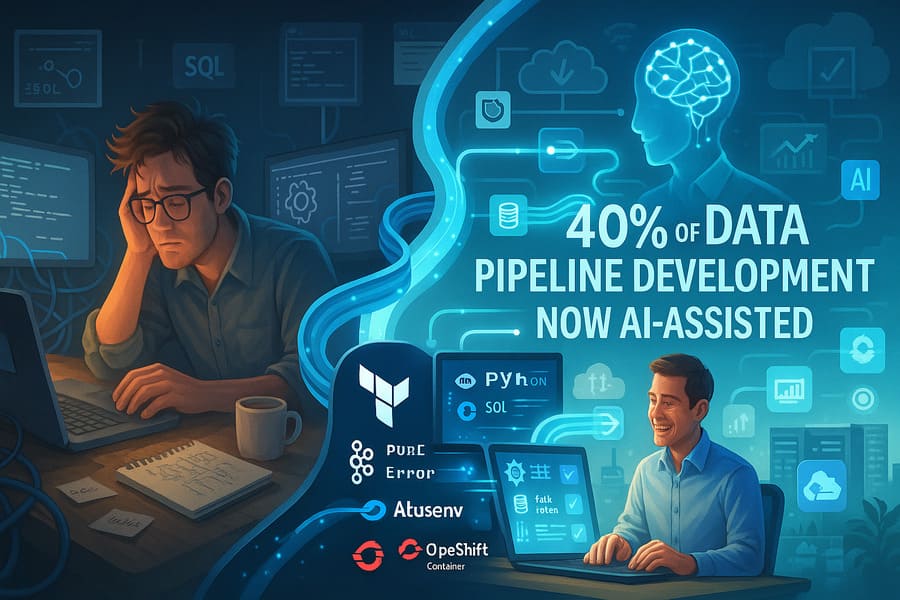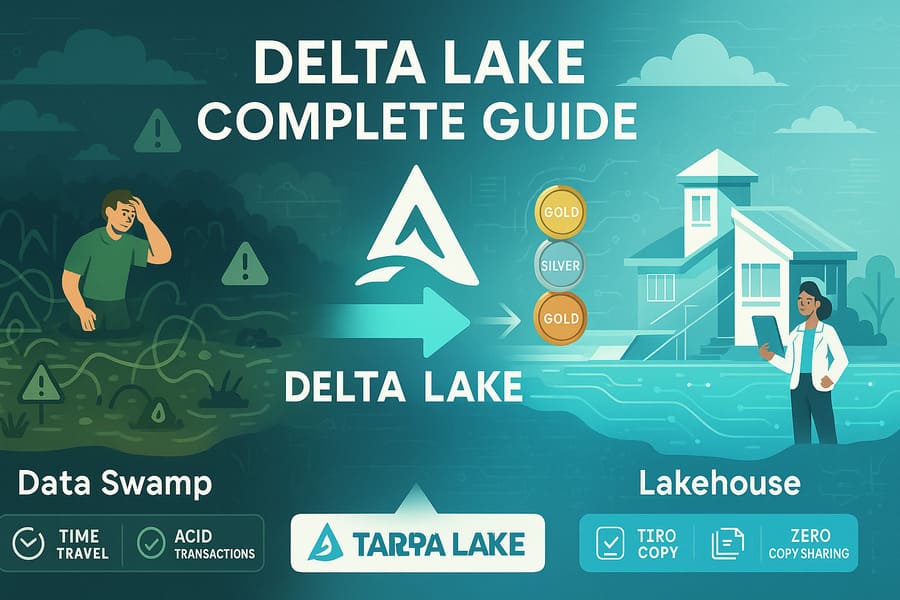Dagster: The Modern Data Orchestration Platform Revolutionizing Pipeline Development
Topic: “From Airflow to Dagster: Why Modern Data Teams Are Making the Switch to Asset-Based Orchestration”
Data orchestration has evolved far beyond simple task scheduling. As data teams grapple with increasingly complex pipelines, data quality requirements, and the need for better observability, traditional workflow orchestrators like Airflow are showing their limitations. Enter Dagster—a next-generation data orchestration platform that’s fundamentally changing how data engineers think about pipeline development, testing, and operations.
This comprehensive guide explores why Dagster is gaining rapid adoption among forward-thinking data teams, how it differs from traditional orchestrators, and provides practical implementation strategies for migrating from legacy systems to modern asset-based orchestration.
The Evolution of Data Orchestration: Why Traditional Tools Fall Short
The Limitations of Task-Centric Orchestration
Traditional orchestration tools like Airflow were designed around the concept of tasks and dependencies. While this approach worked well for simpler ETL processes, modern data engineering faces several challenges that task-centric orchestration struggles to address:
Limited Data Awareness: Traditional orchestrators know about task execution but lack understanding of the data assets being produced and consumed.
Poor Data Quality Integration: Data quality checks are often afterthoughts, implemented as separate tasks rather than integral components of the pipeline.
Testing Complexity: Testing data pipelines requires extensive mocking and setup, making comprehensive testing difficult and time-consuming.
Observability Gaps: Understanding what data assets exist, their lineage, and their current state requires external tools and manual tracking.
Development Experience: Writing, testing, and debugging pipelines often involves complex local environment setup and limited development tooling.
The Asset-Centric Paradigm Shift
Dagster introduces a fundamental shift from task-centric to asset-centric orchestration. Instead of focusing on what tasks to run, Dagster centers on what data assets to produce and how they relate to each other.
This paradigm shift addresses core challenges in modern data engineering:
- Data as First-Class Citizens: Every pipeline produces and consumes well-defined data assets
- Automatic Dependency Resolution: Dependencies are derived from data relationships, not manually defined
- Built-in Data Quality: Data quality checks are native to asset definitions
- Rich Metadata: Comprehensive lineage, schema evolution, and impact analysis out of the box
- Developer Experience: Local development, testing, and debugging capabilities that actually work
Dagster Core Concepts: Building Blocks of Modern Orchestration
Assets: The Foundation of Data-Centric Orchestration
In Dagster, an asset represents a data artifact with a well-defined schema and clear dependencies. Assets can be anything from database tables to machine learning models to dashboard reports.
from dagster import asset, AssetIn
import pandas as pd
import sqlite3
@asset
def raw_customer_data() -> pd.DataFrame:
"""Extract raw customer data from operational database."""
conn = sqlite3.connect("operational.db")
df = pd.read_sql_query("""
SELECT customer_id, first_name, last_name, email,
registration_date, last_activity_date
FROM customers
WHERE registration_date >= date('now', '-30 days')
""", conn)
conn.close()
return df
@asset
def cleaned_customer_data(raw_customer_data: pd.DataFrame) -> pd.DataFrame:
"""Clean and validate customer data."""
# Remove duplicates
df = raw_customer_data.drop_duplicates(subset=['customer_id'])
# Validate email format
df = df[df['email'].str.contains('@')]
# Handle missing values
df['last_activity_date'] = df['last_activity_date'].fillna(
df['registration_date']
)
return df
@asset
def customer_segments(cleaned_customer_data: pd.DataFrame) -> pd.DataFrame:
"""Generate customer segments based on activity patterns."""
df = cleaned_customer_data.copy()
# Calculate days since last activity
df['days_since_activity'] = (
pd.to_datetime('today') - pd.to_datetime(df['last_activity_date'])
).dt.days
# Create segments
def categorize_customer(days_since_activity):
if days_since_activity <= 7:
return 'active'
elif days_since_activity <= 30:
return 'moderate'
else:
return 'at_risk'
df['segment'] = df['days_since_activity'].apply(categorize_customer)
return df[['customer_id', 'segment', 'days_since_activity']]
Software-Defined Assets (SDA): Infrastructure as Code for Data
Software-Defined Assets allow you to define data transformations using familiar tools while gaining Dagster’s orchestration benefits:
from dagster import AssetExecutionContext
from dagster_dbt import DbtCliResource, dbt_assets
@dbt_assets(
manifest=Path("dbt_project/target/manifest.json"),
select="tag:daily_refresh"
)
def dbt_analytics_models(context: AssetExecutionContext, dbt: DbtCliResource):
"""Execute dbt models for daily analytics refresh."""
yield from dbt.cli(["build"], context=context).stream()
# Spark-based transformations
from dagster_spark import spark_asset
from pyspark.sql import SparkSession
@spark_asset
def large_dataset_processing(spark: SparkSession) -> None:
"""Process large datasets using Spark."""
df = spark.read.parquet("s3://data-lake/raw/transactions/")
# Complex aggregations
daily_summary = df.groupBy("date", "product_category").agg(
sum("amount").alias("total_revenue"),
count("transaction_id").alias("transaction_count"),
avg("amount").alias("avg_transaction_value")
)
# Write to data warehouse
daily_summary.write.mode("overwrite").saveAsTable("analytics.daily_revenue")
Sensors and Schedules: Event-Driven and Time-Based Execution
Dagster provides flexible execution models for different use cases:
from dagster import (
sensor,
schedule,
RunRequest,
SkipReason,
DefaultSensorStatus
)
from dagster_aws.s3 import S3Resource
@sensor(
asset_selection=[raw_customer_data],
default_status=DefaultSensorStatus.RUNNING
)
def new_file_sensor(context, s3: S3Resource):
"""Trigger pipeline when new files arrive in S3."""
bucket = "data-ingestion-bucket"
prefix = "customer-data/"
# Check for new files
objects = s3.get_client().list_objects_v2(
Bucket=bucket,
Prefix=prefix
).get('Contents', [])
# Get the latest file
if objects:
latest_file = max(objects, key=lambda x: x['LastModified'])
cursor_value = latest_file['LastModified'].isoformat()
# Check if this is a new file since last run
if context.cursor != cursor_value:
context.update_cursor(cursor_value)
return RunRequest(
partition_key=cursor_value,
tags={"file_key": latest_file['Key']}
)
return SkipReason("No new files detected")
@schedule(
cron_schedule="0 6 * * *", # Daily at 6 AM
asset_selection=[customer_segments]
)
def daily_customer_analysis_schedule():
"""Schedule daily customer segmentation analysis."""
return RunRequest(
tags={"schedule_type": "daily_batch"}
)
Data Quality and Testing: Built-in Validation
Dagster treats data quality as a first-class concern with built-in assertion capabilities:
from dagster import (
asset,
AssetCheckResult,
AssetCheckSeverity,
asset_check
)
import great_expectations as gx
@asset_check(asset=cleaned_customer_data, blocking=True)
def validate_customer_data_quality(cleaned_customer_data: pd.DataFrame):
"""Comprehensive data quality validation for customer data."""
errors = []
# Check for null customer IDs
null_ids = cleaned_customer_data['customer_id'].isnull().sum()
if null_ids > 0:
errors.append(f"Found {null_ids} null customer IDs")
# Check email format validity
invalid_emails = (~cleaned_customer_data['email'].str.contains('@')).sum()
if invalid_emails > 0:
errors.append(f"Found {invalid_emails} invalid email addresses")
# Check for reasonable registration dates
future_dates = (
pd.to_datetime(cleaned_customer_data['registration_date']) >
pd.to_datetime('today')
).sum()
if future_dates > 0:
errors.append(f"Found {future_dates} future registration dates")
# Data freshness check
latest_date = pd.to_datetime(cleaned_customer_data['registration_date']).max()
days_old = (pd.to_datetime('today') - latest_date).days
if days_old > 2:
errors.append(f"Data is {days_old} days old")
if errors:
return AssetCheckResult(
passed=False,
severity=AssetCheckSeverity.ERROR,
description=f"Data quality issues: {'; '.join(errors)}"
)
return AssetCheckResult(
passed=True,
description=f"All quality checks passed for {len(cleaned_customer_data)} records"
)
# Great Expectations integration
@asset_check(asset=customer_segments)
def validate_segments_with_ge(customer_segments: pd.DataFrame):
"""Use Great Expectations for advanced data validation."""
context = gx.get_context()
# Create expectation suite
suite = context.add_or_update_expectation_suite("customer_segments_suite")
# Define expectations
validator = context.get_validator(
batch_request=gx.core.batch.RuntimeBatchRequest(
datasource_name="pandas_datasource",
data_connector_name="default_runtime_data_connector_name",
data_asset_name="customer_segments",
runtime_parameters={"batch_data": customer_segments},
batch_identifiers={"default_identifier_name": "default_identifier"}
),
expectation_suite=suite
)
# Add expectations
validator.expect_column_values_to_be_in_set("segment", ["active", "moderate", "at_risk"])
validator.expect_column_values_to_be_between("days_since_activity", 0, 365)
# Validate
results = validator.validate()
return AssetCheckResult(
passed=results.success,
description=f"Great Expectations validation: {results.statistics}"
)
Practical Implementation: Migrating from Airflow to Dagster
Assessment and Migration Strategy
Phase 1: Assessment and Planning
Before migrating existing Airflow DAGs, conduct a thorough assessment:
# Airflow DAG Analysis Script
import ast
import os
from pathlib import Path
def analyze_airflow_dags(dag_directory):
"""Analyze existing Airflow DAGs for migration planning."""
analysis_results = {
'total_dags': 0,
'task_types': {},
'dependencies': [],
'sensors': 0,
'schedules': {},
'complexity_scores': {}
}
for dag_file in Path(dag_directory).glob("*.py"):
with open(dag_file, 'r') as f:
try:
tree = ast.parse(f.read())
# Extract DAG information
for node in ast.walk(tree):
if isinstance(node, ast.Call):
if hasattr(node.func, 'attr'):
if node.func.attr in ['PythonOperator', 'BashOperator', 'SqlOperator']:
task_type = node.func.attr
analysis_results['task_types'][task_type] = \
analysis_results['task_types'].get(task_type, 0) + 1
analysis_results['total_dags'] += 1
except SyntaxError:
print(f"Could not parse {dag_file}")
return analysis_results
# Usage
airflow_analysis = analyze_airflow_dags("/path/to/airflow/dags")
print(f"Migration scope: {airflow_analysis}")
Phase 2: Asset Identification
Transform task-centric thinking to asset-centric:
# Migration mapping helper
def map_airflow_tasks_to_assets(dag_analysis):
"""Map Airflow tasks to Dagster assets."""
asset_mapping = {}
# Common patterns
patterns = {
'extract_': 'raw_data_assets',
'transform_': 'cleaned_data_assets',
'load_': 'final_data_assets',
'validate_': 'data_quality_checks',
'notify_': 'operational_assets'
}
for task_name in dag_analysis.get('task_names', []):
for pattern, asset_type in patterns.items():
if task_name.startswith(pattern):
asset_mapping[task_name] = {
'asset_type': asset_type,
'suggested_name': task_name.replace(pattern, ''),
'migration_complexity': 'medium'
}
break
else:
asset_mapping[task_name] = {
'asset_type': 'custom_asset',
'suggested_name': task_name,
'migration_complexity': 'high'
}
return asset_mapping
Phase 3: Incremental Migration
Start with leaf nodes (assets with no downstream dependencies):
# Step 1: Create basic asset structure
@asset(
group_name="customer_analytics",
compute_kind="pandas"
)
def migrated_customer_data() -> pd.DataFrame:
"""Migrated from Airflow extract_customer_data task."""
# Original Airflow task logic
return extract_customer_data_logic()
# Step 2: Add data quality that was missing in Airflow
@asset_check(asset=migrated_customer_data)
def check_migrated_data():
"""Add data quality checks that were implicit in Airflow."""
# Implementation here
pass
# Step 3: Gradually replace upstream dependencies
@asset(
deps=[migrated_customer_data] # Start with explicit deps
)
def customer_analytics_report() -> pd.DataFrame:
"""Replace downstream Airflow tasks."""
# Gradually migrate dependent tasks
pass
Handling Complex Migration Scenarios
Multi-DAG Dependencies
from dagster import ExternalAssetDependency
# Handle cross-DAG dependencies during migration
@asset(
deps=[
ExternalAssetDependency("legacy_airflow", "external_data_asset")
]
)
def hybrid_asset() -> pd.DataFrame:
"""Asset that depends on still-running Airflow tasks."""
# Check if external dependency is ready
# Implement fallback logic if needed
pass
Custom Operators Migration
# Wrap custom Airflow operators as Dagster resources
from dagster import resource, ResourceDefinition
@resource
def custom_airflow_operator_resource():
"""Wrap custom Airflow operator as Dagster resource."""
class CustomOperatorWrapper:
def execute(self, **kwargs):
# Migrate custom operator logic
pass
return CustomOperatorWrapper()
@asset
def asset_using_custom_operator(custom_operator: CustomOperatorWrapper):
"""Use migrated custom operator in asset."""
return custom_operator.execute()
Advanced Dagster Patterns for Production Environments
Multi-Environment Configuration
# dagster_project/resources.py
from dagster import EnvVar, ResourceDefinition
from dagster_postgres import PostgresResource
from dagster_aws.s3 import S3Resource
# Environment-specific resource configuration
postgres_resource = PostgresResource(
host=EnvVar("POSTGRES_HOST"),
port=EnvVar.int("POSTGRES_PORT"),
user=EnvVar("POSTGRES_USER"),
password=EnvVar("POSTGRES_PASSWORD"),
database=EnvVar("POSTGRES_DB")
)
s3_resource = S3Resource(
region_name=EnvVar("AWS_REGION"),
aws_access_key_id=EnvVar("AWS_ACCESS_KEY_ID"),
aws_secret_access_key=EnvVar("AWS_SECRET_ACCESS_KEY")
)
# Environment-specific configurations
development_resources = {
"postgres": postgres_resource,
"s3": s3_resource
}
production_resources = {
"postgres": postgres_resource,
"s3": s3_resource,
# Add production-specific resources
"datadog": DatadogResource(api_key=EnvVar("DATADOG_API_KEY"))
}
Partitioned Assets for Large-Scale Data Processing
from dagster import (
asset,
DailyPartitionsDefinition,
AssetExecutionContext
)
from datetime import datetime, timedelta
# Define partitioning strategy
daily_partitions = DailyPartitionsDefinition(
start_date=datetime(2024, 1, 1)
)
@asset(
partitions_def=daily_partitions,
group_name="daily_analytics"
)
def daily_transaction_summary(context: AssetExecutionContext) -> pd.DataFrame:
"""Generate daily transaction summaries with partitioning."""
partition_date = context.partition_key
# Process only data for the specific partition
query = f"""
SELECT
transaction_date,
product_category,
SUM(amount) as total_revenue,
COUNT(*) as transaction_count
FROM transactions
WHERE transaction_date = '{partition_date}'
GROUP BY transaction_date, product_category
"""
df = pd.read_sql(query, connection)
return df
@asset(
partitions_def=daily_partitions,
deps=[daily_transaction_summary]
)
def daily_revenue_report(context: AssetExecutionContext, daily_transaction_summary: pd.DataFrame) -> None:
"""Generate daily revenue reports."""
partition_date = context.partition_key
# Create report for specific partition
report = generate_revenue_report(daily_transaction_summary, partition_date)
# Save to appropriate location
report_path = f"reports/revenue/{partition_date}/daily_report.pdf"
save_report(report, report_path)
Dynamic Asset Generation
from dagster import DynamicPartitionsDefinition, asset
# Dynamic partitions for varying data sources
data_sources_partitions = DynamicPartitionsDefinition(name="data_sources")
@asset(
partitions_def=data_sources_partitions
)
def source_data_ingestion(context: AssetExecutionContext) -> pd.DataFrame:
"""Dynamically ingest data from various sources."""
source_name = context.partition_key
# Dynamic configuration based on source
source_config = get_source_configuration(source_name)
if source_config['type'] == 'api':
return ingest_from_api(source_config)
elif source_config['type'] == 'database':
return ingest_from_database(source_config)
elif source_config['type'] == 'file':
return ingest_from_file(source_config)
raise ValueError(f"Unknown source type: {source_config['type']}")
# Asset factory for generating similar assets
def create_data_quality_asset(table_name: str, schema_name: str):
"""Factory function to create data quality assets."""
@asset(
name=f"dq_{table_name}",
group_name="data_quality"
)
def data_quality_asset() -> AssetCheckResult:
"""Generated data quality check."""
# Implement table-specific quality checks
return perform_quality_checks(schema_name, table_name)
return data_quality_asset
# Generate assets for all tables
tables = [
("customers", "public"),
("orders", "public"),
("products", "inventory")
]
dq_assets = [create_data_quality_asset(table, schema) for table, schema in tables]
Monitoring, Observability, and Operations
Comprehensive Asset Monitoring
from dagster import (
asset,
AssetObservation,
MetadataValue,
AssetExecutionContext
)
import time
@asset
def monitored_data_pipeline(context: AssetExecutionContext) -> pd.DataFrame:
"""Asset with comprehensive monitoring and observability."""
start_time = time.time()
try:
# Execute data transformation
df = perform_data_transformation()
# Record comprehensive metadata
execution_time = time.time() - start_time
context.log_event(
AssetObservation(
asset_key=context.asset_key,
metadata={
"execution_time_seconds": MetadataValue.float(execution_time),
"rows_processed": MetadataValue.int(len(df)),
"data_size_mb": MetadataValue.float(df.memory_usage(deep=True).sum() / 1024 / 1024),
"null_percentage": MetadataValue.float(df.isnull().sum().sum() / df.size * 100),
"data_freshness": MetadataValue.timestamp(time.time()),
"schema_hash": MetadataValue.text(generate_schema_hash(df))
}
)
)
# Log business metrics
context.log.info(f"Processed {len(df)} records in {execution_time:.2f} seconds")
return df
except Exception as e:
context.log.error(f"Pipeline failed: {str(e)}")
# Log failure metadata
context.log_event(
AssetObservation(
asset_key=context.asset_key,
metadata={
"error_message": MetadataValue.text(str(e)),
"execution_time_seconds": MetadataValue.float(time.time() - start_time),
"failure_timestamp": MetadataValue.timestamp(time.time())
}
)
)
raise
Custom Alerting and Notifications
from dagster import (
failure_hook,
success_hook,
HookContext,
RunFailureSkipReason
)
import requests
import json
@failure_hook
def slack_failure_notification(context: HookContext):
"""Send Slack notification on asset failure."""
if isinstance(context.failure_event, RunFailureSkipReason):
return # Skip notifications for skipped runs
# Prepare Slack message
message = {
"text": f"🚨 Dagster Asset Failure Alert",
"blocks": [
{
"type": "section",
"text": {
"type": "mrkdwn",
"text": f"*Asset Failed:* {context.asset_key}\n*Run ID:* {context.run_id}\n*Error:* {context.failure_event}"
}
},
{
"type": "actions",
"elements": [
{
"type": "button",
"text": {"type": "plain_text", "text": "View in Dagster"},
"url": f"{context.dagster_instance.dagit_url}/assets/{context.asset_key}",
"style": "danger"
}
]
}
]
}
# Send to Slack
webhook_url = os.getenv("SLACK_WEBHOOK_URL")
requests.post(webhook_url, data=json.dumps(message))
@success_hook
def data_quality_success_notification(context: HookContext):
"""Send notifications for successful data quality runs."""
# Only notify for data quality assets
if "data_quality" in str(context.asset_key):
# Send to monitoring dashboard
metrics = {
"asset": str(context.asset_key),
"status": "success",
"timestamp": time.time(),
"run_id": context.run_id
}
# Send to metrics collection endpoint
requests.post(
"https://metrics.company.com/dagster/success",
json=metrics
)
Performance Optimization and Scaling
from dagster import (
asset,
AssetExecutionContext,
BackfillPolicy,
AutoMaterializePolicy,
AutoMaterializeRule
)
# Optimize for large-scale processing
@asset(
# Configure automatic materialization
auto_materialize_policy=AutoMaterializePolicy.eager(
max_materializations_per_minute=10
),
# Configure backfill behavior
backfill_policy=BackfillPolicy.single_run(),
# Resource requirements
compute_kind="spark",
group_name="large_scale_processing"
)
def optimized_large_dataset_processing(context: AssetExecutionContext) -> None:
"""Optimized processing for large datasets."""
# Use Spark for distributed processing
spark = get_spark_session(
app_name=f"dagster_asset_{context.asset_key}",
config={
"spark.sql.adaptive.enabled": "true",
"spark.sql.adaptive.coalescePartitions.enabled": "true",
"spark.serializer": "org.apache.spark.serializer.KryoSerializer"
}
)
# Optimize data reading
df = spark.read.option("multiline", "true").parquet("s3://data-lake/large-dataset/")
# Cache frequently accessed data
df.cache()
# Optimize partitioning for output
df.coalesce(100).write.mode("overwrite").parquet("s3://data-warehouse/processed/")
context.log.info(f"Processed {df.count()} records with {df.rdd.getNumPartitions()} partitions")
# Memory-efficient streaming processing
@asset
def streaming_data_processor(context: AssetExecutionContext) -> None:
"""Process streaming data with memory efficiency."""
# Use chunked processing for large datasets
chunk_size = 10000
total_processed = 0
for chunk in pd.read_csv("large_file.csv", chunksize=chunk_size):
# Process chunk
processed_chunk = process_data_chunk(chunk)
# Write incrementally
processed_chunk.to_sql(
"processed_data",
connection,
if_exists="append",
index=False
)
total_processed += len(processed_chunk)
# Log progress
if total_processed % 100000 == 0:
context.log.info(f"Processed {total_processed} records")
context.log.info(f"Total processed: {total_processed} records")
Integration with Modern Data Stack
dbt Integration for Analytics Engineering
from dagster_dbt import DbtCliResource, dbt_assets
from dagster import AssetExecutionContext, AssetKey
@dbt_assets(
manifest=Path("analytics/target/manifest.json"),
select="tag:core_metrics"
)
def core_analytics_models(context: AssetExecutionContext, dbt: DbtCliResource):
"""Execute core analytics dbt models."""
yield from dbt.cli(["build", "--select", "tag:core_metrics"], context=context).stream()
# Combine Dagster assets with dbt models
@asset(
deps=[AssetKey(["analytics", "customer_lifetime_value"])]
)
def clv_predictions(context: AssetExecutionContext) -> pd.DataFrame:
"""Generate CLV predictions based on dbt analytics."""
# Load dbt model output
clv_data = pd.read_sql("""
SELECT * FROM analytics.customer_lifetime_value
WHERE calculation_date = CURRENT_DATE
""", connection)
# Apply ML model
predictions = ml_model.predict(clv_data)
return predictions
Great Expectations Integration
from dagster_ge import ge_validation_op_factory
import great_expectations as gx
# Create validation operations
ge_validation_op = ge_validation_op_factory(
name="validate_customer_data",
datasource_name="postgres_datasource",
data_connector_name="default_configured_data_connector_name",
data_asset_name="customer_data",
suite_name="customer_data_expectations"
)
@asset(
deps=[raw_customer_data]
)
def validated_customer_data() -> pd.DataFrame:
"""Customer data with Great Expectations validation."""
# Load the data
df = load_customer_data()
# Run GE validation
context = gx.get_context()
validator = context.get_validator(
batch_request=create_batch_request(df),
expectation_suite_name="customer_data_expectations"
)
results = validator.validate()
if not results.success:
raise ValueError(f"Data validation failed: {results}")
return df
Machine Learning Integration
from dagster import asset, AssetIn
from dagster_mlflow import MLflowResource
import mlflow
import joblib
@asset
def feature_engineering(raw_data: pd.DataFrame) -> pd.DataFrame:
"""Engineer features for ML model."""
features = raw_data.copy()
# Feature engineering logic
features['days_since_registration'] = (
pd.to_datetime('today') - pd.to_datetime(features['registration_date'])
).dt.days
# Categorical encoding
features = pd.get_dummies(features, columns=['segment'])
return features
@asset(
deps=[feature_engineering]
)
def trained_model(features: pd.DataFrame, mlflow_resource: MLflowResource) -> str:
"""Train and register ML model."""
with mlflow.start_run():
# Prepare training data
X = features.drop('target', axis=1)
y = features['target']
# Train model
from sklearn.ensemble import RandomForestClassifier
model = RandomForestClassifier(n_estimators=100, random_state=42)
model.fit(X, y)
# Log metrics
mlflow.log_metric("accuracy", model.score(X, y))
# Register model
model_path = "models/customer_segmentation"
joblib.dump(model, f"{model_path}/model.pkl")
mlflow.sklearn.log_model(
sk_model=model,
artifact_path="model",
registered_model_name="customer_segmentation"
)
return model_path
@asset(
deps=[trained_model, feature_engineering]
)
def model_predictions(model_path: str, features: pd.DataFrame) -> pd.DataFrame:
"""Generate predictions using trained model."""
# Load trained model
model = joblib.load(f"{model_path}/model.pkl")
# Generate predictions
predictions = model.predict(features.drop('target', axis=1))
prediction_proba = model.predict_proba(features.drop('target', axis=1))
# Create results dataframe
results = features[['customer_id']].copy()
results['predicted_segment'] = predictions
results['confidence'] = prediction_proba.max(axis=1)
results['prediction_date'] = pd.to_datetime('today')
return results
Dagster vs. Alternative Orchestrators: Comprehensive Comparison
Dagster vs. Airflow: Core Differences
| Feature | Dagster | Airflow |
|---|---|---|
| Paradigm | Asset-centric | Task-centric |
| Data Awareness | Native data lineage | Manual tracking |
| Testing | Built-in unit testing | Complex test setup |
| Type Safety | Python type hints | Limited typing |
| Local Development | Excellent dev experience | Limited local testing |
| Data Quality | Native asset checks | External validation |
| Backfills | Asset-aware backfills | Manual dependency management |
| UI/UX | Modern, asset-focused | Task-focused interface |
Dagster vs. Prefect: Modern Orchestrator Comparison
# Dagster approach - Asset-centric
@asset
def processed_data(raw_data: pd.DataFrame) -> pd.DataFrame:
"""Clean and process raw data."""
return raw_data.dropna().reset_index(drop=True)
# Prefect approach - Flow-centric
from prefect import flow, task
@task
def process_data(raw_data: pd.DataFrame) -> pd.DataFrame:
"""Clean and process raw data."""
return raw_data.dropna().reset_index(drop=True)
@flow
def data_processing_flow():
raw = extract_data()
processed = process_data(raw)
return processed
Key Differences:
- Dagster emphasizes what data assets are produced
- Prefect focuses on workflow execution and task orchestration
- Dagster provides better data lineage and catalog capabilities
- Prefect offers more flexible dynamic workflow generation
When to Choose Dagster
Choose Dagster when:
- Data lineage and cataloging are critical requirements
- Your team values strong typing and testing capabilities
- You need integrated data quality validation
- Asset-centric thinking aligns with your data architecture
- You want modern development experience with local testing
Consider alternatives when:
- You have complex dynamic workflow requirements
- Your team is heavily invested in existing Airflow infrastructure
- You need extensive third-party operator ecosystem
- Rapid prototyping of simple workflows is the priority
Advanced Production Patterns and Best Practices
Multi-Tenant Data Architecture
from dagster import (
asset,
AssetExecutionContext,
DynamicPartitionsDefinition,
ConfigurableResource
)
# Define tenant-aware partitioning
tenant_partitions = DynamicPartitionsDefinition(name="tenants")
class TenantAwareResource(ConfigurableResource):
"""Resource that handles multi-tenant data access."""
def get_connection(self, tenant_id: str):
"""Get tenant-specific database connection."""
return get_tenant_database_connection(tenant_id)
def get_s3_prefix(self, tenant_id: str) -> str:
"""Get tenant-specific S3 prefix."""
return f"tenant-data/{tenant_id}/"
@asset(
partitions_def=tenant_partitions,
group_name="tenant_data_processing"
)
def tenant_data_processing(
context: AssetExecutionContext,
tenant_resource: TenantAwareResource
) -> pd.DataFrame:
"""Process data for specific tenant."""
tenant_id = context.partition_key
# Get tenant-specific connection
connection = tenant_resource.get_connection(tenant_id)
# Process tenant data
query = f"""
SELECT * FROM customer_data
WHERE tenant_id = '{tenant_id}'
AND processing_date = CURRENT_DATE
"""
df = pd.read_sql(query, connection)
# Apply tenant-specific processing rules
processing_rules = get_tenant_processing_rules(tenant_id)
processed_df = apply_processing_rules(df, processing_rules)
# Save to tenant-specific location
s3_prefix = tenant_resource.get_s3_prefix(tenant_id)
save_to_s3(processed_df, f"{s3_prefix}processed_data.parquet")
return processed_df
# Tenant management utilities
def add_new_tenant(tenant_id: str, dagster_instance):
"""Add new tenant to dynamic partitions."""
dagster_instance.add_dynamic_partitions("tenants", [tenant_id])
def remove_tenant(tenant_id: str, dagster_instance):
"""Remove tenant from dynamic partitions."""
dagster_instance.delete_dynamic_partition("tenants", tenant_id)
Data Mesh Implementation with Dagster
from dagster import (
Definitions,
asset,
AssetKey,
ExternalAssetDependency
)
# Domain-specific asset groups
@asset(group_name="customer_domain")
def customer_master_data() -> pd.DataFrame:
"""Customer domain master data."""
return load_customer_master_data()
@asset(group_name="order_domain")
def order_transactions(
customer_data: pd.DataFrame # Cross-domain dependency
) -> pd.DataFrame:
"""Order domain transaction data."""
orders = load_order_data()
# Enrich with customer data
enriched_orders = orders.merge(
customer_data[['customer_id', 'segment']],
on='customer_id'
)
return enriched_orders
@asset(group_name="analytics_domain")
def customer_analytics(
customer_data: pd.DataFrame,
order_data: pd.DataFrame
) -> pd.DataFrame:
"""Analytics domain aggregated metrics."""
# Combine data from multiple domains
analytics = customer_data.merge(
order_data.groupby('customer_id').agg({
'order_amount': ['sum', 'count', 'mean']
}),
on='customer_id'
)
return analytics
# Data product definitions for each domain
customer_domain_assets = [customer_master_data]
order_domain_assets = [order_transactions]
analytics_domain_assets = [customer_analytics]
# Domain-specific Definitions
customer_domain_defs = Definitions(
assets=customer_domain_assets,
resources={"database": customer_database_resource}
)
order_domain_defs = Definitions(
assets=order_domain_assets,
resources={"database": order_database_resource}
)
analytics_domain_defs = Definitions(
assets=analytics_domain_assets,
resources={"warehouse": analytics_warehouse_resource}
)
Disaster Recovery and High Availability
from dagster import (
asset,
AssetExecutionContext,
RetryPolicy,
Backoff,
Jitter
)
# Resilient asset with retry policies
@asset(
retry_policy=RetryPolicy(
max_retries=3,
delay=30, # seconds
backoff=Backoff.EXPONENTIAL,
jitter=Jitter.PLUS_MINUS
),
group_name="critical_data_pipeline"
)
def critical_data_processing(context: AssetExecutionContext) -> pd.DataFrame:
"""Critical data processing with disaster recovery."""
try:
# Primary data source
df = load_from_primary_source()
context.log.info("Loaded data from primary source")
except Exception as primary_error:
context.log.warning(f"Primary source failed: {primary_error}")
try:
# Fallback to secondary source
df = load_from_secondary_source()
context.log.info("Loaded data from secondary source")
except Exception as secondary_error:
context.log.warning(f"Secondary source failed: {secondary_error}")
# Fallback to cached data
df = load_from_cache()
context.log.info("Loaded data from cache")
# Set warning metadata
context.log_event(
AssetObservation(
asset_key=context.asset_key,
metadata={
"data_source": MetadataValue.text("cache"),
"warning": MetadataValue.text("Using cached data due to source failures")
}
)
)
return df
# Cross-region backup strategy
@asset
def cross_region_backup(processed_data: pd.DataFrame) -> None:
"""Backup critical data across multiple regions."""
regions = ["us-east-1", "us-west-2", "eu-west-1"]
for region in regions:
try:
# Save to region-specific bucket
s3_client = boto3.client('s3', region_name=region)
bucket_name = f"data-backup-{region}"
# Upload with versioning
timestamp = datetime.now().strftime("%Y%m%d_%H%M%S")
key = f"daily_backup/{timestamp}/processed_data.parquet"
processed_data.to_parquet(f"s3://{bucket_name}/{key}")
except Exception as e:
context.log.error(f"Backup to {region} failed: {e}")
Performance Monitoring and Optimization
from dagster import (
asset,
AssetExecutionContext,
MetadataValue,
AssetObservation
)
import psutil
import time
class PerformanceMonitor:
"""Monitor asset execution performance."""
def __init__(self, context: AssetExecutionContext):
self.context = context
self.start_time = time.time()
self.start_memory = psutil.Process().memory_info().rss / 1024 / 1024 # MB
def __enter__(self):
return self
def __exit__(self, exc_type, exc_val, exc_tb):
end_time = time.time()
end_memory = psutil.Process().memory_info().rss / 1024 / 1024 # MB
execution_time = end_time - self.start_time
memory_used = end_memory - self.start_memory
# Log performance metrics
self.context.log_event(
AssetObservation(
asset_key=self.context.asset_key,
metadata={
"execution_time_seconds": MetadataValue.float(execution_time),
"memory_used_mb": MetadataValue.float(memory_used),
"peak_memory_mb": MetadataValue.float(end_memory),
"cpu_count": MetadataValue.int(psutil.cpu_count()),
"cpu_percent": MetadataValue.float(psutil.cpu_percent()),
}
)
)
@asset
def performance_monitored_asset(context: AssetExecutionContext) -> pd.DataFrame:
"""Asset with comprehensive performance monitoring."""
with PerformanceMonitor(context):
# Execute data processing
df = perform_heavy_computation()
# Log business metrics
context.log_event(
AssetObservation(
asset_key=context.asset_key,
metadata={
"rows_processed": MetadataValue.int(len(df)),
"columns_count": MetadataValue.int(len(df.columns)),
"data_size_mb": MetadataValue.float(
df.memory_usage(deep=True).sum() / 1024 / 1024
),
"null_percentage": MetadataValue.float(
df.isnull().sum().sum() / df.size * 100
)
}
)
)
return df
Troubleshooting and Debugging Strategies
Common Issues and Solutions
Issue 1: Asset Dependencies Not Resolving
# Problem: Circular dependencies or missing type hints
@asset
def asset_a(asset_b): # Missing type hint
return process_data(asset_b)
@asset
def asset_b(asset_a): # Circular dependency
return transform_data(asset_a)
# Solution: Fix type hints and dependency structure
@asset
def raw_data() -> pd.DataFrame:
"""Base data asset with no dependencies."""
return load_raw_data()
@asset
def processed_data(raw_data: pd.DataFrame) -> pd.DataFrame:
"""Process raw data."""
return process_data(raw_data)
@asset
def final_output(processed_data: pd.DataFrame) -> pd.DataFrame:
"""Final transformation."""
return transform_data(processed_data)
Issue 2: Resource Configuration Problems
# Debugging resource issues
@asset
def debug_resource_asset(context: AssetExecutionContext, database: DatabaseResource) -> pd.DataFrame:
"""Asset with resource debugging."""
try:
# Test resource connection
connection = database.get_connection()
context.log.info("Database connection successful")
# Execute query with error handling
df = pd.read_sql("SELECT * FROM test_table LIMIT 10", connection)
context.log.info(f"Query executed successfully, returned {len(df)} rows")
return df
except Exception as e:
context.log.error(f"Resource error: {str(e)}")
context.log.error(f"Database config: {database.dict()}")
raise
Issue 3: Memory and Performance Problems
# Memory-efficient data processing
@asset
def memory_efficient_processing(context: AssetExecutionContext) -> pd.DataFrame:
"""Process large datasets without memory issues."""
chunk_size = 10000
processed_chunks = []
# Process data in chunks
for chunk in pd.read_csv("large_file.csv", chunksize=chunk_size):
# Process each chunk
processed_chunk = chunk.dropna().reset_index(drop=True)
processed_chunks.append(processed_chunk)
# Log progress
context.log.info(f"Processed chunk with {len(processed_chunk)} rows")
# Clear memory
del chunk
# Combine results
result = pd.concat(processed_chunks, ignore_index=True)
# Clean up
del processed_chunks
context.log.info(f"Final result: {len(result)} rows")
return result
Key Takeaways and Implementation Roadmap
Essential Benefits of Dagster Adoption
Data-Centric Approach: Dagster’s asset-centric paradigm aligns naturally with modern data engineering practices, providing better data lineage, cataloging, and quality management than traditional task-based orchestrators.
Developer Experience Excellence: Built-in testing capabilities, type safety, and local development support significantly improve productivity and reduce time-to-deployment for data pipelines.
Production-Ready Features: Native support for partitioning, backfills, monitoring, and resource management makes Dagster suitable for enterprise-scale data operations.
Modern Data Stack Integration: Seamless integration with dbt, Great Expectations, cloud platforms, and ML frameworks enables comprehensive data platform implementation.
Observability and Monitoring: Rich metadata tracking, asset observations, and built-in monitoring capabilities provide unprecedented visibility into data pipeline operations.
Implementation Roadmap
Phase 1: Assessment and Pilot (Weeks 1-4)
- Analyze existing pipeline architecture and identify migration candidates
- Set up Dagster development environment and basic infrastructure
- Migrate 1-2 simple, isolated pipelines as proof of concept
- Establish team training and best practices documentation
Phase 2: Core Infrastructure (Weeks 5-8)
- Implement production Dagster deployment with proper resource management
- Set up monitoring, alerting, and observability infrastructure
- Create reusable asset patterns and organizational standards
- Establish CI/CD pipelines for Dagster code deployment
Phase 3: Gradual Migration (Weeks 9-16)
- Migrate critical data pipelines following dependency order
- Implement comprehensive data quality and testing frameworks
- Integrate with existing data stack (dbt, warehouses, ML platforms)
- Train team on advanced Dagster patterns and troubleshooting
Phase 4: Optimization and Scale (Weeks 17-24)
- Optimize performance for large-scale data processing
- Implement advanced features (partitioning, dynamic assets, sensors)
- Establish data governance and cataloging practices
- Document operational procedures and disaster recovery plans
Success Metrics and KPIs
Technical Metrics:
- Pipeline reliability (99.9%+ success rate)
- Data freshness (reduced lag times)
- Development velocity (faster pipeline creation)
- Test coverage (>80% asset test coverage)
Operational Metrics:
- Reduced incident response time
- Improved data quality scores
- Enhanced data discovery and lineage
- Decreased manual intervention requirements
Business Metrics:
- Faster time-to-insight for analytics
- Improved data-driven decision making
- Reduced infrastructure costs
- Enhanced regulatory compliance
Recommended Learning Resources
Official Documentation:
- Dagster Documentation – Comprehensive guides and API reference
- Dagster University – Structured learning paths
- Asset-Centric Data Orchestration – Core concepts blog post
Community Resources:
- Dagster Slack Community – Active community support
- GitHub Examples Repository – Real-world implementation examples
- Integration Guides – Third-party tool integration documentation
Advanced Topics:
- Performance Optimization Guide – Scaling best practices
- Testing Data Applications – Comprehensive testing strategies
- Deployment Architectures – Production deployment patterns
Dagster represents a fundamental shift in how we approach data orchestration, moving beyond simple task scheduling to comprehensive data asset management. By adopting Dagster’s asset-centric paradigm, data teams can build more reliable, testable, and maintainable data pipelines while gaining unprecedented visibility into their data operations.
The transition from traditional orchestrators to Dagster requires careful planning and gradual implementation, but the benefits—improved data quality, enhanced developer experience, and better operational visibility—make it a compelling choice for modern data engineering teams looking to scale their operations and improve their data infrastructure.





